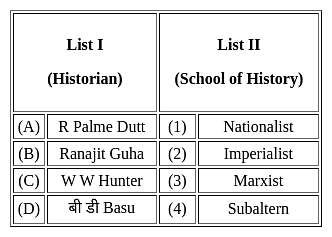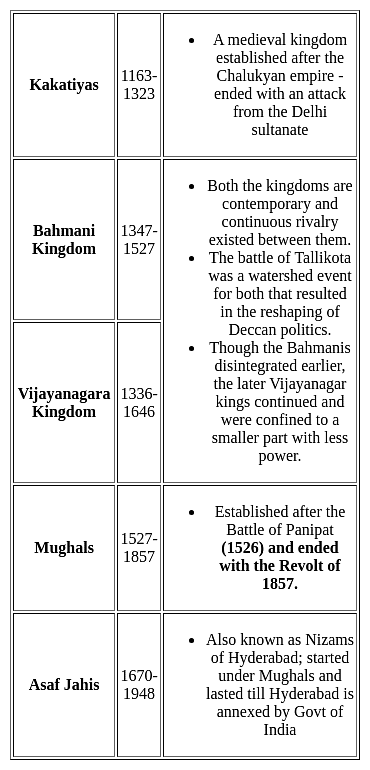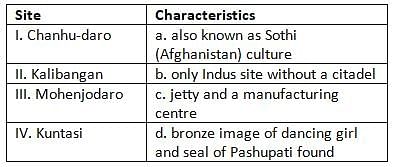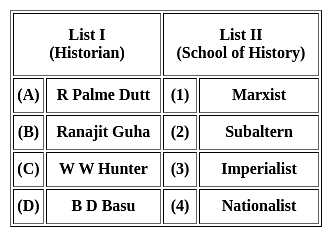MH SET Paper 2 Mock Test - 8 (History) - MAHA TET MCQ
30 Questions MCQ Test - MH SET Paper 2 Mock Test - 8 (History)
Gandhiji’s' ideology, best articulated in his seminal work, “Hind Swaraj” written in 1909, expounds that
1. Industrial capitalism was held responsible for all conflicts of interests, for it divorced economic activities from moral concerns.
2. The ancient Indian civilization "unquestionably the best", was the fountainhead of Indian nationality, as it had immense assimilative power of absorbing foreigners of different creeds.
3. Parliamentary Democracy did not reflect the general will of the people, but of the political parties.
Which of the above statements is/are correct?
Direction: The following item consists of two statements, statement I and statement II. Examine these two statements carefully and select the correct answer from the code given below.
Statement I:
Satvahans kings followed the custom of naming themselves after their mother.
Statement II:
Succession to the throne was matriarchal and women occupied an important position in society.
| 1 Crore+ students have signed up on EduRev. Have you? Download the App |
Match the following Press acts with their corresponding Governer Generals and choose the correct answer from the codes given below 

Arrange the following Kingdoms in chronological order.
a. Bahmani kingdom
b. Vijayanagara Kingdom
c. Asaf Jahis
d. Kakatiyas
e. Mughals
Which of the following places belong to Jain architecture?
- Statue of Gomateswara at Sravanabelgola
- Bahubali statue at Karkal
- Caves of Udaigiri hills
- A tower at Chittor
- A temple at Dilwara
Select the correct answer using the codes given below:
Consider the following statements with reference to the poetry tradition of Indian history:
1. The Samhitas are a compilation of hymns, prayers and archetypal poetry.
2. Malatibhava, written by Kalidasa, is a part of Early Sanskrit literature.
3. In Sangam literature, while Ettutogai is a collection of eight anthologies of poems, Pathupattu is a collection of ten long poems.
4. Under Telugu literature, song literature called pattu flourished.
Which of the above statements is/are correct?
Which of the following statements are correct?
1. The EIC lost monopoly of trade with the Charter of 1813.
2. The use of Indian ships for trade was banned.
3. It was made obligatory for the British Government to purchase only British-made paper for use in India.
4. Measures such as 2 and 3 ultimately ruined Indian industries.
Consider the following statements with regard to Kakatiyas and select correct statements:
(A) Agriculture was the main profession during Lakatiya rule
(B) Forests cleared and new areas were brought under cultivation
(C) Land Revenue was collected both in cash and kind.
(D) Irrigation was not given importance.
Direction: Answer the following questions by selecting the correct / most appropriate options.
Statement A): Both Jaina and Buddhist monks went from place to place throughout the year, teaching people.
Statement B): Supporters of Jaina and Buddhists built temporary shelters for them in gardens, or they lived in natural caves in hilly areas.
Consider the following statements regarding Sher Shah Gate.
1. The gate served as the southern entrance to Shergarh.
2. Shergarh was built when Sher Shah took control of the Mughal Empire after defeating emperor Humayun.
Which among the above statements is/are correct?
Consider the following statements about colonialism in India.
Statement (I): Each social class and group felt the effects of colonialism equally.
Statement (II): The notion of freedom was not always the same for each class and group.
Which of the following statements given below is/are correct?
Which among the following is / are the hallmark features of Neolithic revolution?
- A transition from hunting-gathering to food production
- A transition from plenty of use of copper to Iron
- Rise of domestication of various types of plants and animals
Choose the correct option from the codes given below:
Stupas have a great significance in Buddhist architecture. In this reference, consider the following statements about the Bharhut stupa:
- It was initially built by Ashoka and was later improvised by the Sungas.
- Its railing contains numerous birth stories of the Buddha’s previous lives or Jataka stories.
- It represents the aniconic phase of Buddhist art.
Which of the statements given above is/are correct?
Consider the following statements with reference to the Gupta period.
1. Parnadatta was appointed the Provincial governor of Saurashtra by Rudradaman.
2. The Vallabhi era is identical with the Harsha era.
3. Chandragupta Maurya called himself ‘Lichchavi-dauhitra’.
4. Manusmriti is regarded as the official law book of the Guptas.
Which of the above statements is/are not correct?With reference to the Anglo-Maratha Wars, consider the following statements:
1. The main cause of the first Maratha war was the increased interference of the British in internal and external affairs.
2. The First Anglo-Maratha War was fought between the British East India Company and Maratha Empire, during 1775 - 1782.
3. After many battles both Marathas and Britishers signed the Treaty of Salbai to Conclude the first Anglo-Maratha War in 1782.
Which of the above statement is/are correct?
With reference to the Battle of Plassey, consider the following statements:
1. The Battle of Plassey became famous because it was the first major victory the Company won in India.
2. After the defeat at Plassey, Siraj Ud-Daulah was assassinated and Mir Qasim made the nawab.
3. After the battle of Plassey the Company immediately took over the responsibility of the administration.
Which of the statements given above is/are correct?
With reference to the medieval Indian history, match List I with List II, and select the correct answer by using the codes given below the lists:
List - I
I. Alberuni
II. Minhaj Siraj
III. Barani
IV. Amir Khusrau
List - II
a. Tabaqat-i-Nasiri
b. Tarikh-i-Firozshahi
c. Tahkik-i-Hind
d. Miftah-ul-Futuh
Codes:
Match the historians mentioned in the List I with List II. Select the correct code given below:

Consider the following statements about the officers Muhtasib appointed by Aurangzeb:
1. They were appointed to see that intoxicants were not consumed in public places.
2. They were also responsible for checking weights and measures.
Which of the statements given above is/are correct?Consider the following statements regarding Barabar caves:
- They are the oldest example of rock-cut architecture in India.
- These caves are associated with Buddhism only.
- A famous cave at Barabar caves is Lomas Rishi cave, which is known for a horse shoe fashion decorated facade.
Which of the statements given above is/are correct?
Who among the following were supported by Dupleix during the Second Carnatic War?
- Nasir Jang
- Muzaffar Jang
- Anwar-Ud-Din
- Chanda Sahib
Choose the correct option from the codes given below :
Consider the following statements about the Indian Freedom Struggle :
1. With the help of Hitler, the ‘Freedom Army’ (Mukti Sena) was formed which consisted of all the prisoners of war of Indian origin captured by Germany, Italy and Japan.
2. Subhash Chandra Bose came to be called ‘Netaji’ by the people of Germany.
Which of the above statement(s) is/are correct?
Consider the following events in the history of India:
1. Rise of Pratiharas under King Bhoja.
2. Establishment of Pallava power under Mahendravarman - I
3. Pala dynasty founded by Gopala.
4. Establishment of Chola power by Parantaka - I
What is the correct chronological order of the above events, starting from the earliest time? (2020)Consider the following statements regarding the relations between India and Pakistan
1) During Shimla Agreement, Indira Gandhi and Zulfikar Bhutto agreed to maintain the sanctity of LOC.
2) Lahore summit took place in the year 1997.
3) Islamabad summit was held between Rajiv Gandhi and Nawaz Sharif.
Which of these statement(s) is/are correct?
Consider the following Pairs:
 How many pair/s given above is are correctly matched?
How many pair/s given above is are correctly matched?
Which of the following statements is correct?
I. Tipu Sultan is also known as the Tiger of Mysore.
II. Tipu Sultan ruled over Mysore from 1782 to 1799.
Below given are two statements, one is labelled as Assertion (A) and the other as Reason (R):
Assertion (A): Mughal painters who migrated to the Deccan during the period of Aurangzeb were responsible for the development of various other centres of paintings in Deccan, such as Hyderabad.
Reason (R): The Deccani school of painting developed under the influence of the Mughal style from the beginning.
Select the correct answer using the codes given below:





















